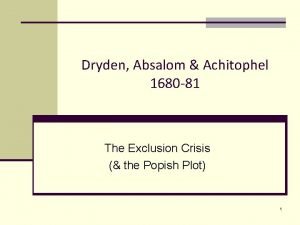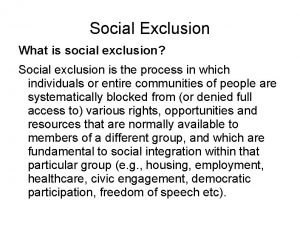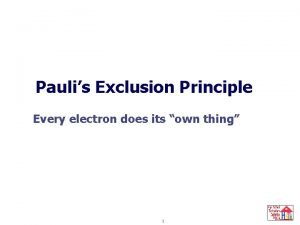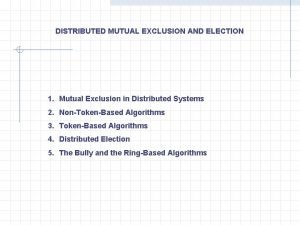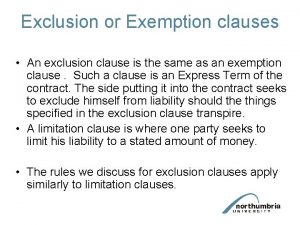The Exclusion Crisis The Exclusion Crisis Timeline 1670











- Slides: 11

The Exclusion Crisis

The Exclusion Crisis: Timeline 1670 s Growing Fears of Catholic influence in England 1673 Test Act requires public official to make an anti-Catholic oath. Duke of York’s resigns as Lord High Admiral. 1677 An Account of the Growth of Popery and Arbitrary Government, a pamphlet possibly by Andrew Marvell Is published. 1678 (July) Titus Oates produces 43 articles alleging a Catholic plot to assassinate Charles II and take over English government. The King I s informed of the supposed plot the following month. Titus Oates

The Exclusion Crisis: Timeline 1678 (Oct. ) Sir Edmund Berry Godfrey found dead – gives the plot some credibility. (Oct. ) Oates appears before House of Commons and accuses five Catholic Lords of being conspirators. The Earl of Shaftesbury has them arrested. (Dec) Second Test Act: Catholics excluded from Parliament. 1679 Mass hysteria and anti-Catholic paranoia sweeping across London. (May) The Commons passes the first Exclusion Bill. King dissolves Parliament in response. The Earl of Shaftesbury

The Exclusion Crisis: Timeline 1679 (Summer) Shaftesbury begins meeting with the Duke of Monmouth. (Jun. ) Five Jesuit priests hanged. (Sept) Charles sends Monmouth into exile in Europe to calm the crisis. (Nov. ) Monmouth returns to London uninvited to widespread rejoicing. 1680 (Spring-summer) Monmouth actively promoting himself and touring country. His popularity grows. (Oct. ) Parliament finally meets again. Second Exclusion Bill passes easily, but is rejected by the Lords. The Duke of Monmouth

The Exclusion Crisis: Timeline 1680 (Dec) Trial of the five Lords begins. Lord Stafford first to be found guilty and beheaded the same month. 1681 (Jan) Charles II dissolves Parliament again. (Mar. ): Parliament called in Oxford. Third Exclusion Bill introduced, but King dissolves it after a week. (Summer) Oates arrested for sedition and confined in prison. Shaftesbury also arrested on charges of treason. (Nov. ) Trial of. Shaftesbury. Dryden publishes Absalom and Achitophel to coincide. Shaftesbury is acquitted. The Viscount Stafford

The beginnings of party politics Whigs • Opposed the Court’s corruption. • Opposed the government’s persecution of Protestant Nonconformists. • Sought to reaffirm the rights and power of parliament. Tories • Supported Charles I. • More broadly, supported a strong monarchy and a strong Church of England. Venice Preserv’d sometimes described as a “Tory tragedy”.

The Politics of Venice Preserv’d Dedication to Duchess of Portsmouth Of her son, the Duke of Richmond: “May he grow up to be a Bulwark to his illustrious Father, and a Patron to his Loyal Subjects, Wisdom and Learning to assist him, whenever call'd to his Councils, to defend his right against the encroachments of Republicans in his Senates, to cherish such men as shall be able to vindicate the Royal Cause, that good and fit servants to the Crown, may never be lost for want of a Protector. ” The Duchess of Portsmouth

The Politics of Venice Preserv’d Prologue In these distracted times, when each man dreads The bloody stratagems of busy heads; When we have feared three years we know not what, Till witnesses begin to die o' th' rot, What made our poet meddle with a plot?

The Politics of Venice Preserv’d Ian Mc. Kellen as Pierre (on the wheel in Act 5). Photo from the National Theatre’s 1984 production of Venice Preserv’d, dir. Peter Gill

She-Tragedy

She-Tragedy Laura Brown, ‘The Defenseless Woman and the Development of English Tragedy’, SEL, 22. 3 (1982), 429 -443. She-tragedy “portrays a new kind of heroine, whose victimization provides the essential material of the plot and whose defenselessness constitutes a specific contrast to the defiance of the passionate and ambitious female characters in the preceding heroic play. But more important, the rise of the she-tragedy coincides with a major transition in the genre: the transition from the aristocratic heroic drama of the coterie Restoration theater to the "bourgeois tragedy”. ”
 1670 fur trade
1670 fur trade Exclusion crisis in absalom and achitophel
Exclusion crisis in absalom and achitophel Itk sisekliinik
Itk sisekliinik Iran hostage crisis timeline
Iran hostage crisis timeline Cuban missile crisis timeline
Cuban missile crisis timeline Cuban missile crisis timeline
Cuban missile crisis timeline Stable electronic configuration
Stable electronic configuration Dieta de exclusion materna
Dieta de exclusion materna Habitat v niche
Habitat v niche Mutual exclusion adalah
Mutual exclusion adalah Mutual exclusion in distributed systems
Mutual exclusion in distributed systems Competitive exclusion vs resource partitioning
Competitive exclusion vs resource partitioning

